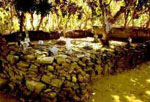|
Selasa, 16 September 2008 |
| Kertanagara
|
 The last and most well known of the Singosari kings was Kertanagara. Praised in the Nagarakertagama as a devout Buddhist, well versed in many branches of philosophy and esoteric science, he is considered to have been the first Javanese ruler to envision a united Indonesia. Kertanagara's dreams, however, were not to be fully realized until half a century after his death, during the reign of King Hayam Wuruk of Majapahit. The expansionist foreign policy which he pursued, partly as a response to the increasing threat posed by the Mongol emperor, Kublai Khan, was perhaps too ambitious. His expedition to Bali in 1284 was inconclusive, while the army which he sent to subjugate the kingdom of Malayu in lower Sumatra left him unable to cope with rebellion closer to home. Kertanagara had, further, lost the favour of a number of powerful and influential statesmen, who had been loyal to his father, Wishnuwardhana. Two of these especially, the former prime minister Mpu Raganata and the security advisor Aria Wiraraja, had been relegated to lower positions in the new government. The last and most well known of the Singosari kings was Kertanagara. Praised in the Nagarakertagama as a devout Buddhist, well versed in many branches of philosophy and esoteric science, he is considered to have been the first Javanese ruler to envision a united Indonesia. Kertanagara's dreams, however, were not to be fully realized until half a century after his death, during the reign of King Hayam Wuruk of Majapahit. The expansionist foreign policy which he pursued, partly as a response to the increasing threat posed by the Mongol emperor, Kublai Khan, was perhaps too ambitious. His expedition to Bali in 1284 was inconclusive, while the army which he sent to subjugate the kingdom of Malayu in lower Sumatra left him unable to cope with rebellion closer to home. Kertanagara had, further, lost the favour of a number of powerful and influential statesmen, who had been loyal to his father, Wishnuwardhana. Two of these especially, the former prime minister Mpu Raganata and the security advisor Aria Wiraraja, had been relegated to lower positions in the new government.
According to one historical account, the Kidung Panji Wijayakrama, the rebellion which led to Kertanagara's death in 1292 was, in part, incited by Wiraraja, who had been given a relatively minor position as governor of Sumenep in Madura.
From information contained in the inscription of Mula Malurung, we learn that Kertanagara, as crown prince and heir apparent to the throne of Singosari, had already been installed as ruler of Kediri in 1254, fourteen years before his father's death. This event was unlikely to have pleased his brother-in-law, Jayakatwang, who claimed direct descent from the old kings of Kediri, and who was thus looking for an opportunity for revenge. The moment came in 1292. Despite repeated warnings from his ministers, Kertanagara did not recognize the weakness of his position. The result was that he died defending his palace, together with many of his closest followers, heavily outnumbered by the forces of Jayakatwang. The story of the gallant but hopeless defense put up by his son-in-law, Raden Wijaya, has been preserved in detail in the famous Kudadu inscription, discovered on the slopes of Mt Butak, to the south of Mojokerto. The inscription relates how the two commanders, Raden Wijaya and Ardaraja, had been given the task of defending the area north of the Singosari capital. Ardaraja, however, who was a son of Jayakatwang, is said to have betrayed his comrade and, perhaps on account of divided loyalty, gone over to the enemy. Reduced finally to an exhausted force of just twelve men, Raden Wijaya fled across the Strait of Madura and took refuge with Aria Wiraraja in Sumenep. From there he designed his strategy to return to the mainland.
The role played by Aria Wiraraja in the fall of Singosari and the birth of Majapahit has not yet been fully understood. On the one hand he is said to have influenced Jayakatwang to rebel against Kertanagara; yet he also sheltered Raden Wijaya and offered advice on how the young exile could establish a new kingdom. Raden Wijaya was not long in acting. He returned to Kediri, where he offered his allegiance to Jayakatwang, in return for a small area of forest land at Tarik, near Mojokerto. Here, together with a band of loyal Madurese followers, he founded the new settlement of Majapahit. |
|
| 0 Comments: |
|
| |
 |
| |
|
|





